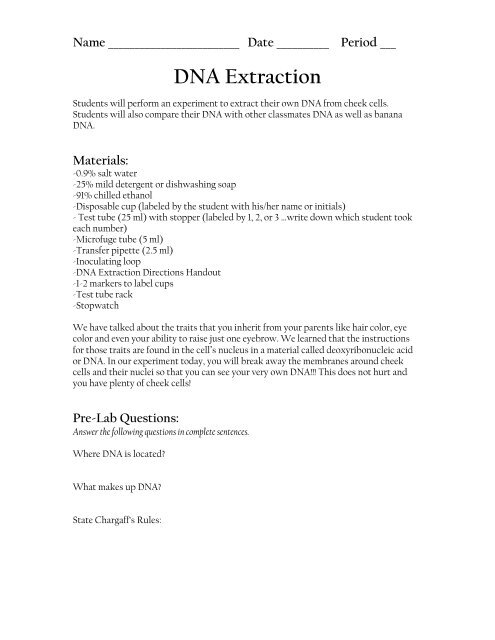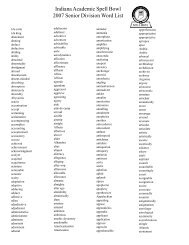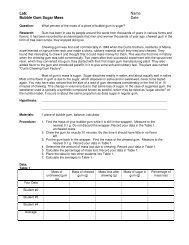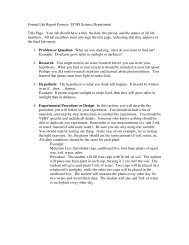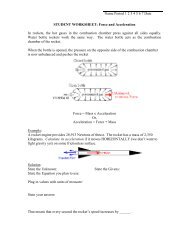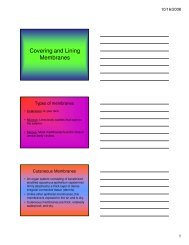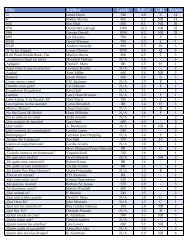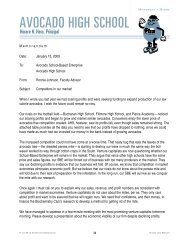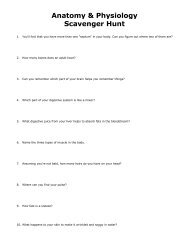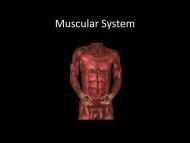DNA Extraction Lab
DNA Extraction Lab
DNA Extraction Lab
You also want an ePaper? Increase the reach of your titles
YUMPU automatically turns print PDFs into web optimized ePapers that Google loves.
Name _________________________ Date __________Period ___<strong>DNA</strong> <strong>Extraction</strong>Students will perform an experiment to extract their own <strong>DNA</strong> from cheek cells.Students will also compare their <strong>DNA</strong> with other classmates <strong>DNA</strong> as well as banana<strong>DNA</strong>.Materials:-0.9% salt water-25% mild detergent or dishwashing soap-91% chilled ethanol-Disposable cup (labeled by the student with his/her name or initials)- Test tube (25 ml) with stopper (labeled by 1, 2, or 3 …write down which student tookeach number)-Microfuge tube (5 ml)-Transfer pipette (2.5 ml)-Inoculating loop-<strong>DNA</strong> <strong>Extraction</strong> Directions Handout-1-2 markers to label cups-Test tube rack-StopwatchWe have talked about the traits that you inherit from your parents like hair color, eyecolor and even your ability to raise just one eyebrow. We learned that the instructionsfor those traits are found in the cell’s nucleus in a material called deoxyribonucleic acidor <strong>DNA</strong>. In our experiment today, you will break away the membranes around cheekcells and their nuclei so that you can see your very own <strong>DNA</strong>!!! This does not hurt andyou have plenty of cheek cells!Pre-<strong>Lab</strong> Questions:Answer the following questions in complete sentences.Where <strong>DNA</strong> is located?What makes up <strong>DNA</strong>?State Chargaff’s Rules:
Procedure:1. Use your transfer pipette to measure 10 milliliters (ml) of salt water. Add this to yourcup. Make sure to return the pipette to the proper beaker.2. Now use your pipette to measure 5 ml of the detergent solution. Add this to your 25 mltest tube. Make sure to return the pipette to the proper beaker.3. Next, take the salt water in your cup and swish it in your mouth while gently scrapingyour teeth against your cheeks for 60 seconds. Be careful not to bite your cheeks.4. Spit the water back into your cup. Pour this into your test tube that already containsthe 5 ml of the detergent solution.5. Gently put the stopper on the test tube and gently rock it on its side for 2-3 minutes.By doing this, the detergent breaks the cell membrane to release the <strong>DNA</strong>. It is importantto gently rock the test tube. If you shake too hard, the <strong>DNA</strong> will be broken up into verysmall pieces.6. Using the pipette, measure 5 ml of chilled 95% ethanol. Make sure you return thepipette to the proper beaker.7. Open and slightly tilt your 25 ml test tube. Carefully add the 5 ml of ethanol down theside of the test tube. You will see that the ethanol forms a layer on top of your soapysolution.8. Allow the test tube and solution to stand for 1 minute in the test tube rack. Whilewaiting, transfer 5 ml of the ethanol into the 5 ml microfuge tube. Set aside.9. Now you should see some white, stringy material in the test tube. Grab yourinoculation loop. Place loop (loop end) into the tube and twirl it just like you twirl yourfork when you eat spaghetti. This will wind the <strong>DNA</strong> strands around the loop. Be carefuland try not to mix the ethanol and soapy layers.10. After you have wrapped as much as you can onto the loop, remove the loop andscrape/shake the <strong>DNA</strong> into a 5 ml microfuge tube containing 95% ethanol. Your <strong>DNA</strong>will stay solid in this solution.11. Notify your teacher to come around and glue the cap on to the tube for safe keeping.Post <strong>Lab</strong> Questions:Answer the following questions in complete sentences.When the cells are placed in the detergent solution, the detergent dissolves what in thecell membrane? (hint: detergent dissolves grease on your dishes).Each “glob” of material contains how many <strong>DNA</strong> strands?Compare your <strong>DNA</strong> with other classmates as well as the banana <strong>DNA</strong>. Identify anydifferences and similarities.


